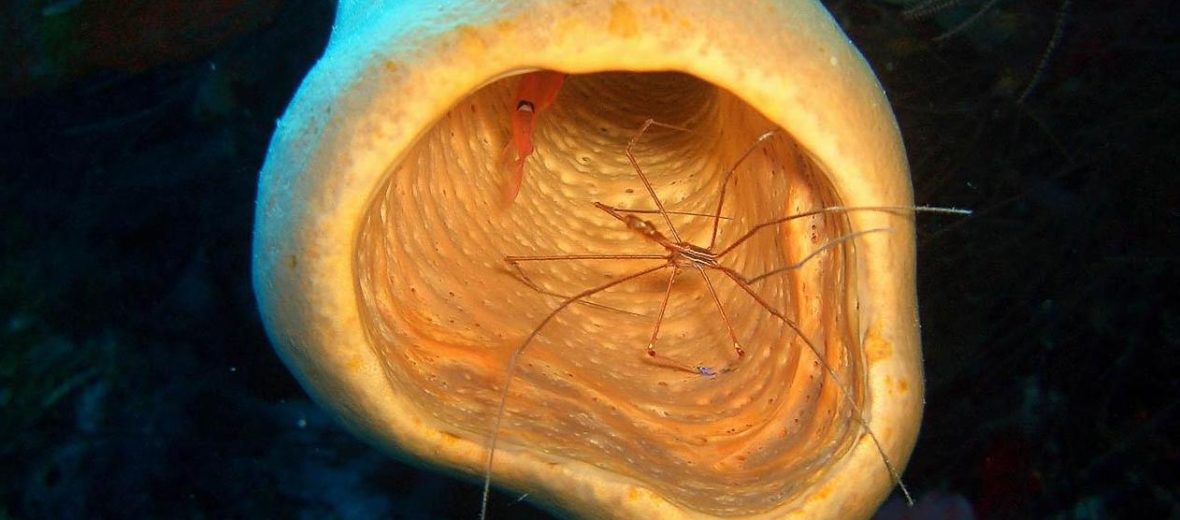
The sponge has been around for an awfully long time; 600 million years! That is since the Precambrian period of our planet’s history. With approximately 8,550 different described species of sponge, there are a lot to pick from. Found from shallow water to 3.1 miles deep and in saltwater and freshwater systems, these critters are specialized and diverse animals that are often overlooked. These critters deserve more credit than they get.
First the Stats…
Scientific name: Porifera
Weight: Up to 20 lbs.
Length: Up to 6 feet
Lifespan: Up to 5,000+ years
Now on to the Facts!
1.) Sponges act as a kind of gill, in that they filter the surrounding water and extract plankton and other nutrients to feed itself.
2.) The sponge is the simplest known multicellular organism.
3.) Their various colorations are to help protect them from the harmful effects of ultraviolet light.
4.) Even though they are classified as animals, they lack a head, eyes, brain, nerves, legs, arms, ears, muscles, or even organs.
5.) The only known predators of sponges are some species of fish, some sea turtles, and some invertebrates.
But wait, there’s more on the sponge!
6.) In the nutrient-depleted coral reefs, there are certain sponges which are thought to make carbon biologically and readily available by excreting a form of feces (poop) that other organisms rely on to survive. Living on sponge poop. There’s a thing you can’t unlearn.
7.) 1 difference between corals and sponges is that corals live as small sea anemone-like polyps, usually in colonies of numerous identical individuals. Sponge bodies consist of a jelly-like mesohyl inbetween 2 thin layers of cells.
Did you know…?
Some species of sponges produce toxins and are thus poisonous.
8.) They are unique in having some specialized cells which can transform into other types of cells.
9.) The sponges that reproduce asexually produce buds or gemmules, that are packets of several cells of various types inside a protective covering.
10.) Most sponges are hermaphrodites (contain both male and female reproductive organs). They are therefor able to reproduce sexually.
But wait, there’s still more on the sponge!
11.) While most sponges are considered sessile (immobile), some species of sponge can move at the blinding speed of up to 0.157 inches per day.
12.) There are about 137 known species of carnivorous sponges.
Did you know…?
Synalpheus regalis shrimp utilize their host sponge not only as a food source, but also as a defense against other shrimp and a variety of other predators. As many as 16,000 individuals can inhabit a single loggerhead sponge!
13.) Freshwater sponges sometimes host green algae as endosymbionts within archaeocytes and other cells that the sponge gains nutrients from in the form of chlorophyll.
14.) Numerous sponges shed spicules that form a thick carpet, several feet deep, that keeps away echinoderms (worms) which would otherwise look to prey on them.
15.) Sponge flies, aka spongilla-flies, are specialized predators of freshwater sponges. The female lays her eggs on the overhanging vegetation. The larvae hatch and drop into the water where they look for sponges to feast on. They use their elongated mouth parts to pierce the sponge and suck the fluids out. The larvae of some species cling to the surface of the sponge while others seek refuge in the sponge’s internal cavities. The fully grown larvae leave the water and spin a cocoon in which to pupate into an adult fly.
But wait, there’s still a little more on the sponge!
16.) The Caribbean chicken-liver sponge secretes toxins that can kill surrounding coral polyps, thus allowing the sponges to grow over the bleached coral skeletons. This is called bioerosion.
17.) Some Caribbean sponges suffer from Aplysina red band syndrome. This causes Aplysina to develop 1 or more rust-colored bands, sometimes with accompanying bands of necrotic (dead) tissue. This condition is contagious and affects up to 10% of the sponges in the Caribbean.
Did you know…?
Some sponges have medicinal potentials due to the presence in sponges themselves or their microbial symbionts of chemicals that may be used to control bacteria, tumors, viruses, and fungi.
18.) Most sponges are detrivores (filter organic debris particles and microscopic life forms from ocean water). In particular, many sponges have an important role as detrivores in coral reef food webs by recycling detritus to higher trophic (food web) levels.
19.) In a behavior known as sponging, dolphins will attach a sponge to their rostrum (snout) and will use it to protect themselves when searching for food in the sandy bottom.
20.) Certain objects with sponge-like textures are now made of substances not derived from sponges. Synthetic sponges include items like personal and household cleaning tools, breast implants, and contraceptive sponges.
Now a Short Sponge Video!
Be sure to share & comment below! Also, check out the Critter Science YouTube channel. Videos added regularly!
Want to suggest a critter for me to write about? Let me know here.
Think you know a lot about critters? Try your hand at these fun, free quizzes:



